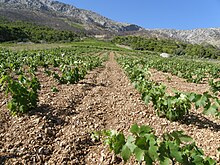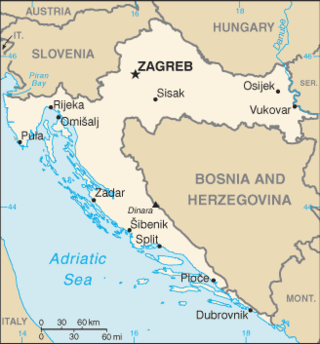Viticulture in Croatia
In the south of Croatia , bevanda (heavy, aromatic red wine, diluted with tap water) is particularly popular , especially during meals , while in the north-western regions, however, it is gemišt (from the German expression: "mixed") or špricer (from "spritzer" or " Spritzter “) (acidic white wines, diluted with mineral water).
history
The latest research shows that the Illyrians in this area already knew the grapevine in the Bronze and Iron Ages . But the correct development of viticulture is associated with the establishment of the first Greek settlements on the islands. A writing from this period (The Feast of the Scholars) testifies to the production of wine in the Greek colony of Issa (today the island of Vis ). With the arrival of the Romans , viticulture was significantly promoted. The Croats developed after their settlement in Dalmatia viticulture next to the olive-growing and fishing an important industry. The late medieval free towns regulated and protected viticulture through legal norms and statutes. Viticulture was made more difficult by the so-called wine clause or the privileged import of Italian wines at the end of the 19th century during the Austro-Hungarian era . The new foundations for the further development of viticulture have been laid since the 1990s. These are mainly family wineries.
Wine regions of Croatia

Croatia has 60,000 hectares of vineyards and is divided into two main regions: northern, continental and Mediterranean Croatia (also known as the Croatian coast ). It is further divided into twelve sub-regions, which in turn are divided into cultivation areas.
The sub-region belongs to the main region of continental Croatia.
- Srijemsko vinogorje ( Srijem Wine Region )
- Erdutsko vinogorje ( Erdut Wine Region )
- Baranjsko vinogorje ( Baranja Wine Region )
Slavonia sub-region (Slavonia)
The sub-region belongs to the main region of continental Croatia. Wine has been grown in Kutjevo and Ilok since the 13th century. Are particularly appreciated white wines of the grape varieties Riesling (Graševina), Pinot Gris (Pinot Sivi), Traminer (Traminac) and Chardonnay .
- Đakovačko vinogorje ( Đakovo wine region )
- Slavonskobrodsko vinogorje ( Slavonski Brod Wine Region )
- Novogradiško vinogorje ( Nova Gradiška Wine Region )
- Požeško-pleterničko vinogorje ( Požega Wine Region )
- Kutjevačko vinogorje ( Kutjevo Wine Region )
- Daruvarsko vinogorje ( Daruvar Wine Region )
- Pakračko vinogorje ( Pakrac Wine Region )
- Feričanačko vinogorje ( Feričanci Wine Region )
- Orahovičko-slatinsko vinogorje ( Orahovica - Slatina wine region )
- Virovitičko vinogorje ( Virovitica Wine Region )
Moslavina sub-region
The sub-region belongs to the main region of continental Croatia.
- Volodersko-Ivanićgradsko vinogorje ( Voloder Wine Region - Ivanić Grad )
- Čazmansko-Garešničko vinogorje ( Čazma - Garešnica Wine Region )
Prigorje - Bilogora sub-region
The sub-region belongs to the main region of continental Croatia.
- Dugoselsko-Vrbovečko vinogorje ( Dugo Selo Wine Region )
- Kalničko vinogorje ( Kalnik Wine Region )
- Koprivničko-Đurđevačko vinogorje ( Koprivnica - Đurđevac Wine Region )
- Bjelovarsko-Grubišnopoljsko vinogorje ( Bjelovar - Grubišno Polje Wine Region )
- Zelinsko vinogorje (Sv.Ivan Zelina Wine Region )
- Zagrebačko vinogorje ( Zagreb Wine Region )
Pokuplje sub-region
The sub-region belongs to the main region of continental Croatia.
- Karlovačko vinogorje ( Karlovac Wine Region )
- Petrinjsko vinogorje ( Petrinja Wine Region )
- Vukomeričko vinogorje ( Vukomeričke gorice wine region )
Plešivica sub-region

The sub-region belongs to the main region of continental Croatia.
- Samoborsko vinogorje ( Samobor Wine Region )
- Plešivičko-Okićko vinogorje ( Plešivica Wine Region )
- Svetojansko-Slavetnićko vinogorje ( Sveta Jana - Slavetić wine region )
- Krašićko vinogorje ( Krašić Wine Region )
- Ozaljsko-Vivodinsko vinogorje ( Ozalj - Vivodina Wine Region )
Zagorje- Međimurje sub-region
The sub-region belongs to the main region of continental Croatia. Mainly Riesling and Graševina are grown here
- Međimursko vinogorje ( Međimurje Wine Region )
- Varaždinsko vinogorje ( Varaždin Wine Region )
- Ludbreško vinogorje ( Ludbreg Wine Region )
- Krapinsko vinogorje ( Krapina Wine Region )
- Zlatarsko vinogorje ( Zlatar Wine Region )
- Zabočko vinogorje ( Zabok Wine Region )

Istra sub-region (Istria)
The sub-region belongs to the main region of Mediterranean Croatia. Malvazija Istarska and Merlot thrive best in Istria .
- Zapadno (western) istarsko vinogorje (western Istria wine region)
- Centralno istarsko vinogorje (Central Istria Wine Region)
- Istočno istarsko vinogorje (Eastern Istria Wine Region)
Hrvatsko Primorje sub-region (coastal area)
The sub-region belongs to the main region of Mediterranean Croatia.
- Opatijsko-Riječko-Vinodolsko vinogorje (Wine Region Opatija - Rijeka - Vinodol )
- Krčko vinogorje ( Krk Wine Region )
- Rapsko vinogorje ( Rab wine region )
- Cresko-Lošinjsko vinogorje ( Cres - Lošinj Wine Region )
- Paško vinogorje ( Pag wine region )
Northern Dalmatia Sub-Region (Sjeverna Dalmacija)
The sub-region belongs to the main region of Mediterranean Croatia.
- Zadarsko-Biogradsko vinogorje ( Zadar Wine Region - Biograd )
- Benkovačko-Stankovačko vinogorje ( Benkovac - Stankovci Wine Region )
- Pirovačko-Skradinsko vinogorje ( Pirovac - Skradin Wine Region )
- Kninsko vinogorje ( Knin Wine Region )
- Prominsko vinogorje ( Promina Wine Region )
- Šibensko vinogorje ( Šibenik Wine Region )
- Primoštensko vinogorje ( Primošten Wine Region )
Sub-region Dalmatian hinterland ( Zagora )
The sub-region belongs to the main region of Mediterranean Croatia.
- Sinjsko-Vrličko vinogorje ( Sinj - Vrlika Wine Region )
- Imotsko vinogorje ( Imotski Wine Region )
- Vrgorsko vinogorje ( Vrgorac Wine Region )
- Drniško vinogorje ( Drniš \ Petrovo Polje wine region )
Sub-region of Central and South Dalmatia (Srednja / Južna Dalmacija)
The sub-region belongs to the main region of Mediterranean Croatia.
- Kaštelansko-Trogirsko vinogorje ( Kaštela - Trogir wine region )
- Splitsko-Omiško-Makarsko vinogorje (wine region Split - Omiš - Makarska )
- Neretvansko vinogorje ( Neretva Wine Region )
- Konavosko vinogorje ( Konavle Wine Region )
- Mljetsko vinogorje ( Mljet Wine Region )
- Pelješko vinogorje ( Pelješac Wine Region ). From the Mali Plavac grape variety , not far from the town of Potomje on the south coast of the peninsula, a well-known Croatian red wine that does not need to shy away from international comparison, the Dingač . The vineyard area on Pelješac has been increasing continuously for several years due to the excellent climatic conditions. A large number of the excellent red wines produced here are simply called Plavac or Pelješac. Rukatac (also known by another name Maraština ), as made in Oskorušno , is quite acceptable among the white people .
- Korčulansko vinogorje ( Korčula Wine Region )
- Lastovsko vinogorje ( Lastovo Wine Region )
- Viško vinogorje, island of Vis (Vis wine region). Numerous archaeological finds prove that vines have been cultivated here continuously for more than 2000 years. Mainly white varieties are represented here: Trbljan , Vugava , Maraština , Kurtelaška . Many consider Vugava to be the oldest variety on the island. Allegedly it dates back to the time of the Greek colonization. It has a specific golden yellow color, a special aroma and is known for its rich and rich honey taste. This is why this strain is often said to be eaten rather than drunk. The Vugava can be experienced particularly well when the harvest begins on Vis in autumn, when the wine cellars are opened and the barrels are carried out. Then the places smell very special. Vugava is an early ripening variety, so it is usually used to start the harvest in Dalmatia.
- Hvarsko vinogorje, the island of Hvar ( Hvar wine region) is ideally suited for wine-growing with up to 2697 hours of sunshine per year. The inhabitants of the Greek settlement Pharos cultivated the first vineyards near the present-day cities of Jelsa and Stari Grad before the birth of Christ. Today original white varieties predominate here: u. a. Cetinka , Mekuja , Bogdanuša , Maraština , which are seldom represented in other areas. Bogdanuša wine is greenish-yellow in color and has a slightly bitter taste. Maraština has a specific yellow to golden yellow color, a fine aroma and a rich, very harmonious taste. The wine regions on the south side of the island are completely different, much rougher and more picturesque. Many of the vineyards here are very difficult to reach, let alone cultivate them by hand, which is the only option here. Characteristic for this area are u. a. the ruby red, fiery Plavac , the first class Faros and Ivan Dolac .
- Bračko vinogorje ( Brač Wine Region ), the most impressive vineyards on the island of Brač, are located on their southern slopes above the village of Bol . They are grown here on sloping small terraces. The dark red Bolski Plavac is characterized by its pleasant bitterness and specific bouquet .
- Soltansko vinogorje
sorts
Coastal strip of Dalmatia
On the coastal strip, the vineyards drop steeply down to the sea, so that the vines are maximally illuminated by the sun. The Plavac mali variety is predominantly grown here. It is an autochthonous Dalmatian variety that grows in dry soils and requires a lot of solar heat. Recent genetic research into the origins of Plavac mali shows the links between this variety and the famous American variety Zinfandel .
Pakleni Otoci
On the Pakleni otoci (Hellish Islands) , off the coast of the town of Hvar on the island of the same name, the new Pošip grape vines thrive .
Other wine-growing regions
- Biševo island
A special feature of Croatian labels is that the alcohol content must be specified to the nearest tenth of a percent and not rounded. (e.g. 11.3 percent is not rounded up to 11.5 percent as in France or Germany ).
